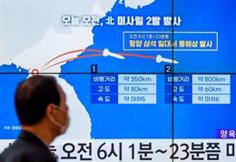One of the missiles crosses the maritime demarcation line for the first time since the end of the war
Nov. 2 (EUROPA PRESS) –
The North Korean authorities have once again set off all the alarms: with the launch of more than twenty ballistic missiles and the firing of a hundred artillery rounds, Pyongyang has openly violated the demarcation line in the Sea of Japan on Wednesday in some actions that point to a new nuclear test in the coming weeks.
The South Korean Army has warned that six other missile launches have been detected both towards the East Sea and towards the Yellow Sea, among which are several surface-to-air projectiles.
These launches, which are added to three others previously carried out and which include 17 missiles, have been carried out in just ten hours and represent a violation of the military agreement reached between the two Koreas and a violation of the disputed maritime demarcation line in the Yellow Sea.
Four of the missiles have been launched from the areas of Jeongju and Pihyeon Gun, in Pyongan province, in the north of the country, according to information from the Yonhap news agency.
Subsequently, Pyongyang has fired another three missiles from Wonsan, which have been followed by another ten surface-to-air missiles launched from Nakwon, in Jeongpyeong, which has led the South Korean authorities to authorize the launch of three ballistic missiles into the sea of Japan in order to deter North Korean forces.
Seoul has immediately condemned the increase in tension, especially after one of these missiles fell just 60 kilometers from its coast. Thus, it has accused Pyongyang of violating the military pacts and has ordered the Army to remain undisturbed.
The military considers the latest North Korean actions as a “clear provocation, launched near South Korean territorial waters south of the maritime demarcation line”, something that calls into question “stability and peace on the Korean peninsula”.
That is why the Armed Forces have assured that “they will maintain a preventive posture to respond when necessary and guarantee the security of the South Korean people in the face of any type of provocation while cooperation with the United States is analyzed” and other allies.
In this sense, Seoul has lamented that the inter-Korean military agreement has turned out to be “useless” since the launches of both parties have included the crossing of missiles over the established delimitation line. The pact completely suspended any hostile action between the two countries in an attempt to avoid “accidental military confrontations”.
The president of South Korea, Yoon Seok Yeol, has not been slow to call an emergency meeting of the National Security Council and has called for a “forceful” response to any “significant attempt to invade the territory.”
For his part, the Japanese Prime Minister, Fumio Kishida, has confirmed that the country has already presented a note of protest to the North Korean Embassy in Beijing and has stressed that Pyongyang is acting at an “unprecedented pace”, something “unacceptable”.
Kim Jong Un has repeatedly insisted that the North Korean missile program is part of legitimate self-defense and the idea of ”being ready to mobilize in full capacity” in case of external attack.
The North Korean leader continues to accuse the United States of trying to “demonize North Korea” to justify its policies and insists that the measures taken by Washington against the country are purely “illegal and hostile”.
Kim maintains that the attitude of the North American country pushes North Korea, the victim of “dangerous” actions that place it in a compromised place, one step away from the war conflict, although the US authorities insist that it is a “pretext” for “further provocations,” according to State Department spokesman Ned Price.
The policies promoted by Yoon, who advocates strengthening the alliance with the United States and give a new meaning to the so-called ‘Kill Chain’, the Seoul system designed to “raze” North Korea in a matter of minutes if necessary, have caused a increased tension.
The plan includes an air defense system to defeat enemy ballistic missiles, a large-scale protocol to attack Pyongyang and a series of decisive strikes that would kill the country’s top leaders, including Kim Jong Un. However, the idea is mainly to prevent the launch of the missiles in question from the North Korean side.
North Korea is seen by many as preparing to carry out its seventh nuclear test since its last one in September 2017.


![[Img #74664]](https://thelatestnews.world/wp-content/uploads/2024/12/James-Watson-The-controversial-genius-behind-the-double-helix-150x150.jpg)








